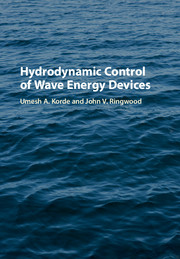Book contents
- Frontmatter
- Contents
- Preface
- Acknowledgments
- Part I Introduction
- Part II The Basics
- 2 Introduction to Control Engineering
- 3 Bodies Oscillating in Air
- 4 Bodies Oscillating in Water
- Part III The Hydrodynamics
- Part IV Velocity Control Using a Hydrodynamic Model
- Part V Control by Optimizing a Performance Index
- Part VI Toward Overall WEC System Hydrodynamic Optimization
- Part VII In Closing
- References
- Index
4 - Bodies Oscillating in Water
from Part II - The Basics
Published online by Cambridge University Press: 05 September 2016
- Frontmatter
- Contents
- Preface
- Acknowledgments
- Part I Introduction
- Part II The Basics
- 2 Introduction to Control Engineering
- 3 Bodies Oscillating in Air
- 4 Bodies Oscillating in Water
- Part III The Hydrodynamics
- Part IV Velocity Control Using a Hydrodynamic Model
- Part V Control by Optimizing a Performance Index
- Part VI Toward Overall WEC System Hydrodynamic Optimization
- Part VII In Closing
- References
- Index
Summary
We noted in Chapter 3 that for bodies oscillating in air, control of motion in response to an irregular excitation requires only current motion information. We have assumed a control hardware with an infinitesimally small response time, as we will in the following discussion. In this chapter we see that, when a body oscillates in response to waves on the water surface, motion information from the future is required in the control of the motion at the current instant – even if all control hardware were to respond instantaneously. We find that control to produce optimal absorption from a wave to which the body is currently responding requires knowledge of the body response to the waves it will encounter up to several seconds into the future. While this poses no serious challenge in the regular wave idealization, for real irregular seas modeled as random phenomena, such knowledge is difficult to obtain. In the sections that follow, we attempt to understand the fundamental physics underlying this need for future information. We begin to learn here why impedance matching control such as considered in Chapter 3 is not possible for a floating body in irregular waves, unless one could find some way to predict or estimate either the body's velocity or the incident wave profile. It is useful to note that our understanding here is based on linear theory, and if the waves are too large in height or body oscillations are too large, we would need to amend our thinking. However, it is also useful to realize that in such situations, our attention would be more on surviving the situation and less on energy conversion.
Oscillation Near Free Surface
A more direct analogue to a body oscillating in air is an oscillating body that is submerged deep in water, such that the water surrounding it in all directions can, for all practical purposes, be thought to be unbounded or infinite in extent. A body oscillating in a fluid must lose some energy due to viscous friction in the boundary layer surrounding it, and therefore encounters an opposing damping force. In addition, as the body accelerates and decelerates, so must a quantity of fluid surrounding it.
- Type
- Chapter
- Information
- Hydrodynamic Control of Wave Energy Devices , pp. 70 - 88Publisher: Cambridge University PressPrint publication year: 2016



